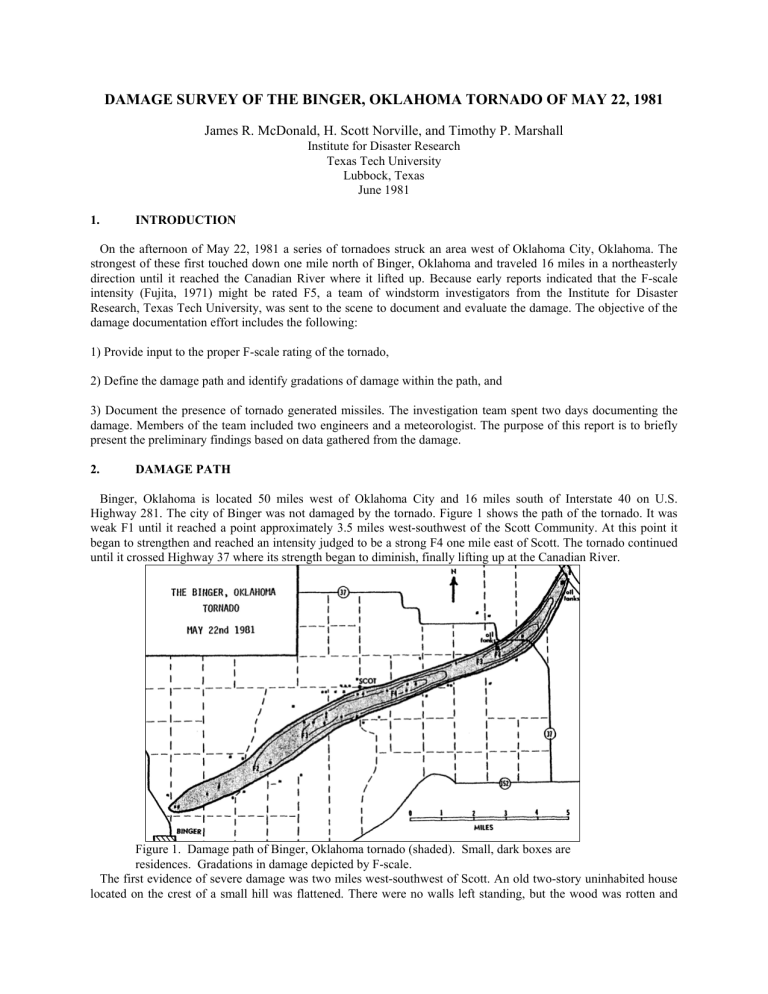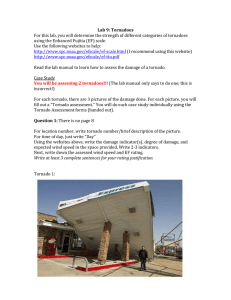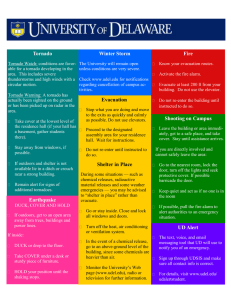DAMAGE SURVEY OF THE BINGER, OKLAHOMA TORNADO OF MAY 22,... James R. McDonald, H. Scott Norville, and Timothy P. Marshall

DAMAGE SURVEY OF THE BINGER, OKLAHOMA TORNADO OF MAY 22, 1981
James R. McDonald, H. Scott Norville, and Timothy P. Marshall
Institute for Disaster Research
Texas Tech University
Lubbock, Texas
June 1981
1. INTRODUCTION
On the afternoon of May 22, 1981 a series of tornadoes struck an area west of Oklahoma City, Oklahoma. The strongest of these first touched down one mile north of Binger, Oklahoma and traveled 16 miles in a northeasterly direction until it reached the Canadian River where it lifted up. Because early reports indicated that the F-scale intensity (Fujita, 1971) might be rated F5, a team of windstorm investigators from the Institute for Disaster
Research, Texas Tech University, was sent to the scene to document and evaluate the damage. The objective of the damage documentation effort includes the following:
1) Provide input to the proper F-scale rating of the tornado,
2) Define the damage path and identify gradations of damage within the path, and
3) Document the presence of tornado generated missiles. The investigation team spent two days documenting the damage. Members of the team included two engineers and a meteorologist. The purpose of this report is to briefly present the preliminary findings based on data gathered from the damage.
Binger, Oklahoma is located 50 miles west of Oklahoma City and 16 miles south of Interstate 40 on U.S.
Highway 281. The city of Binger was not damaged by the tornado. Figure 1 shows the path of the tornado. It was weak F1 until it reached a point approximately 3.5 miles west-southwest of the Scott Community. At this point it began to strengthen and reached an intensity judged to be a strong F4 one mile east of Scott. The tornado continued until it crossed Highway 37 where its strength began to diminish, finally lifting up at the Canadian River.
Figure 1. Damage path of Binger, Oklahoma tornado (shaded). Small, dark boxes are residences. Gradations in damage depicted by F-scale.
The first evidence of severe damage was two miles west-southwest of Scott. An old two-story uninhabited house located on the crest of a small hill was flattened. There were no walls left standing, but the wood was rotten and
weak. Two houses across the road to the east were destroyed, but both still had strong walls standing (F3). One was a classic example of a small bathroom remaining intact while the exterior walls were destroyed (Fig. 2). A mile farther east a house lost its roof, carport and some exterior walls, but most of the other walls remained intact.
Another mile east two houses were totally destroyed, along with a number of large oak, walnut and cottonwood trees. Automobiles and heavy farm equipment (grain truck, combine and tractor) were rolled and tumbled up to 50 yards. Large trees were uprooted. One 24-inch diameter tree was snapped off two feet above ground. Where trees did not uproot or snap off, all leaves and limbs were stripped off leaving only the very largest branches.
Additional evidence of the power of the storm was observed 4.5 miles west of the Scott community, as the tornado approached Highway 37. Several large oil storage tanks reportedly were blown away from the Amoco Petroleum
Corporation lease. One of the tanks (Fig. 3), which had been taken out of service a week earlier because it was struck by lightning, was found 1500 ft south of its original location. The survey team could not find the other two tanks that reportedly were at the lease site. The oil company has been contacted in an effort to locate them. One half mile east of the oil lease, a farm house and barn were destroyed (Figs. 4 and 5). Debris from the house was had been cleaned up by the time the survey team arrived. However, damage to the barn and farm implements, along with the types of missiles generated, indicated F4 tornado intensity at this location. A pickup truck rolled more than 500 ft into a ravine. It was totally disintegrated (Fig. 6).
Figure 2. Farm house destroyed by the tornado. Interior walls remain standing around bathroom. Damage to this house was rated F-3 on the
Fujita scale.
Figure 3. Empty oil storage tank at Amoco lease. This storage tank rolled and tumbled 1500 feet.
Figure 4. Remains of pole barn found on farm near Rt. 37.
Figure 5. Damage to trees and farm equipment. Large branches were broken off, however, trees were not debarked.
Figure 6. Remains of pickup truck. Ground marks indicated that the vehicle rolled and tumbled 500 feet.
One and possibly two oil storage tanks were blown from a lease located near the bank of the Canadian River. The lease was 2.5 miles north and 0.5 mile east of the point where Highway 37 turns northwest. The well belongs to
Woods Petroleum Corporation. One of the oil tanks was found in a deep ravine that leads to the Canadian River, approximately 200 yards from its original location (Fig. 7). A second tank possibly had been pulled from the ravine and hauled away before the investigation team arrived. We were not able to verify this with oil company personnel, but tracks in the area seemed to indicate this. The tank was similar to the one located at the Amoco lease.
Figure 7. Oil storage tank deposited in a ravine. The tank was 20 feet tall and
12 feet in diameter. It rolled through a wheat field and down this ravine about
200 yards.
Because the tornado passed through uninhabited farm and pasture land, the dollar value of loss was relatively small. There were no reported deaths or injuries. All of the farm houses that were in the path had storm shelters. The tornado was visible for a long distance; hence, people had ample warning of the impending storm. Several eyewitnesses said that they stood and watched the storm from a safe vantage point. Description of the funnel cloud by eyewitnesses was similar to the one that struck Wichita Falls, Texas on April 10, 1979.
3. F-SCALE
The F-scale rating is based on the worst damage observed along the tornado path. Figure 1 shows contours of the severity of the tornado as determined from a ground survey of the damage path. There were two segments of F4 damage. The first segment is based on damage to two houses and the destruction of large trees, which were uprooted, snapped off or stripped of their leaves and branches. The damage at this location appeared to be in the upper part of the F4 range. The second F4 segment crossed the Amoco oil lease and destroyed a farm house and barn near Highway 37. The farm house was leveled. Numerous large missiles were rolled and tumbled up to 500 ft.
The reasons for rating F4 instead of F5, as was suggested in initial reports of the damage, are as follows:
1) Although several houses in the path were essentially leveled, their age and rural-type construction leaves their relative strength open to question. Factors other than house damage should be considered in arriving at an F-scale rating.
2) Autos and heavy farm machinery were rolled and tumbled distances up to 500 ft, but there was no evidence that any of them "flew" any great distances.
3) Trees up to 24 in. in diameter were snapped off and numerous others were uprooted. Of those that remained standing, leaves and limbs were broken off, but trunks were not debarked.
4) Although the oil storage tanks were blown some distance, all were empty and exposed large surface areas to the wind. Extremely high wind speeds are not required to explain movement of the tanks.
4. GRADATIONS OF DAMAGE
Figure 1 indicates that the total length of the path, which encloses F1 damage or greater, is 16 mi. The maximum damage path width was one mi. The average width over the 16-mile length was 1275 yards. Thus, the Fujita-
Pearson scale rating for this tornado is F4, PL3, PW4, i.e., 4, 3, 4. The length of path by F-scale is given in the table below, in relatively open country, it is not possible to define the limits of FO damage.
F-scale
Length, mi
LENGTH OF F-SCALE DAMAGE
F1 F2 F3 F4 F5
4.5 4.5 4.75 2.25 --
Total
16
5. TORNADO-GENERATED
Types of missiles generated by the tornado typically were pieces of timber from damaged houses and barns, automobiles and pickup trucks, farm equipment, and oil storage tanks. Timbers included pieces that ranged in size from 2 x 4 to 2 x 8, some as long as 12 feet. The timbers generally were oriented in the same direction on the ground. Automobiles and pickup trucks were rolled and tumbled up to 500 feet. Ground marks were found to establish that they did not fly. The ones that traveled the greatest distances were totally disintegrated.
Figure 8 shows the path taken by the oil storage tank on the Amoco lease. The tank was 12 feet in diameter and 20 feet tall. Walls of the tank were 0.25 steel plate. Ground marks were used to identify the path taken by the tank.
Movement of the tank was caused by the counterclockwise winds of the tornado as the storm passed south of the tank battery. Future study includes tornado missile trajectory simulation of this oil tank as it was affected by the storm.
Figure 8. Track of ground marks of empty oil storage tank. The tank rolled and tumbled but did not fly. It traveled in an arcshaped path about 1500 feet.
6. CONCLUSIONS
Although there were no injuries or deaths and a relatively small amount of property damage, when compared with other more devastating tornadoes, the Binger tornado of May 22, 1981 was no doubt a powerful storm. Evidence gathered from a ground survey of the storm indicates that it should be classified as a high F4 on the Fujita-scale.
Damage to houses, trees, and equipment was severe, but not sufficiently bad to justify an F5 rating. The missiles generated by this tornado, although interesting, do not require unusually high wind speeds to explain their behavior.
7. ACKNOWLEDGEMENTS
The cooperation of personnel at the National Severe Storms Laboratory, Norman, Oklahoma, in coordinating this damage survey is gratefully acknowledged. Much additional information about this storm during its life cycle was obtained by the NSSL tornado chase team. Funds for this tornado damage documentation effort were provided by
the U.S. Nuclear Regulatory Commission Contract No. NRC-04-76-345. Robert F. Abbey, Jr., serves as contract monitor on the project.
8. REFERENCES
Fujita, T. T., 1971: "Proposed Characterization of Tornadoes and Hurricanes by Area and Intensity," SMRP
Research Paper No. 91, The University of Chicago, Chicago, Illinois.





